Redfern, the convict doctor who saved thousands of lives.
Dr William Redfern, came as a convict to New South Wales. In 1814, he reported on the causes of an epidemic on convict ships and made recommendations for preventing further outbreaks, creating the first public health document in Australia.
Despite the efforts of naval surgeon James Lind, and Captain James Cook to improve the lot of seamen in the eighteenth century, conditions on board ships were wretched— cramped and often damp below decks, no ventilation, lack of hygiene, little attempt to prevent disease, poor nutrition, and discipline enforced by floggings. These same conditions were considered appropriate for the transportation of convicts. William Redfern was remarkable in helping to transform not only the convict experience, but the health of all those in the navy and on immigrant ships.
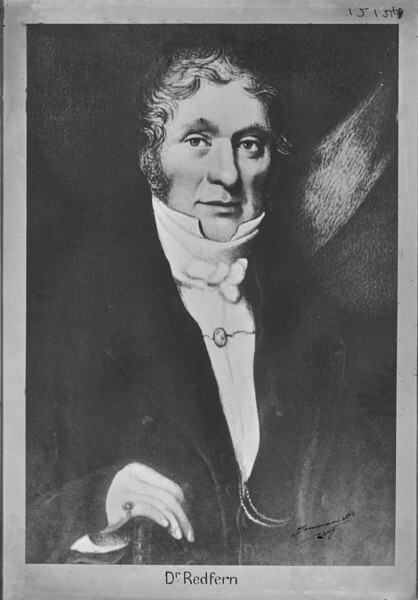
Dr William Redfern painted by George Marshall Maher (1832). Reproduced with the permission of Damian Greenish and the State Library of New South Wales.
How a humanitarian doctor became a convict.
William Redfern began his working life as an assistant naval surgeon onboard His Majesty’s ship Standard. It was here that he witnessed the dreadful conditions which seamen endured, and as a well-educated gentleman, perhaps it came as a shock to realise that people commonly lived in such a wretched state. Within months of Redfern joining the fleet at Nore in 1797, a mutiny broke out as the seamen pressed for improved conditions and pay.
Months before, the Channel Fleet at Spitfield had successfully bargained for the same terms and received no repercussions. However, the mutineers at Nore went further and made political demands which caused the authorities to take a different approach – 29 of the mutineers were executed, and many others were imprisoned and flogged.
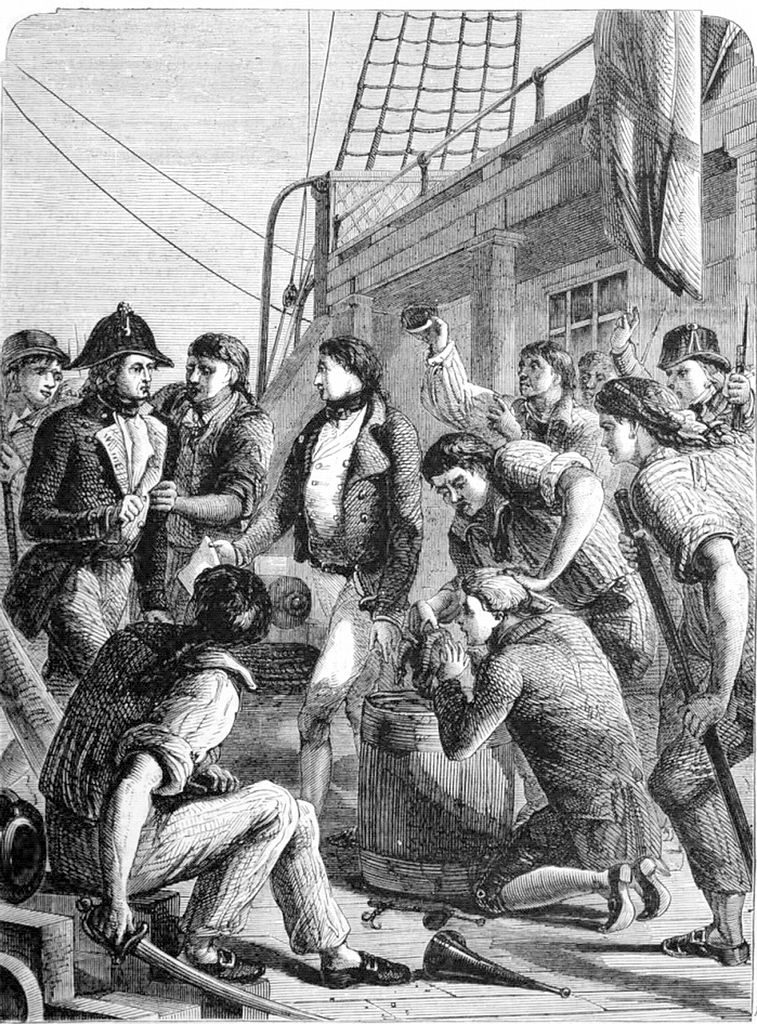
Seamen complaining of their rations, previous to the mutiny at Nore. Cassell’s Illustrated History of England. Vol 6 (1865). Redfern recognised the seamen’s need for nutritious food, better living conditions and adequate pay.
Redfern was the only officer condemned to death. He had reputedly given support to the mutineers, advising them “to be more united among themselves”1. Due to his age – only 19 – Redfern was spared, discharged from the Royal Navy without pay, and sentenced to lifetime imprisonment. He applied for transportation to Australia and after four years’ incarceration, he was sent to New South Wales on the Minorca.
During the voyage he helped care for his fellow prisoners and upon arrival in the colony his value as a surgeon was recognised. He was sent to Norfolk Island for several years and then settled, with a full pardon, in Sydney. Employed by the Colonial Medical Service, he worked for the government as well as in his own private practice.
The outbreak of typhus fever
In 1814, three convict ships arrived in Sydney having all suffered a distressingly high loss of life during the voyage; this effected both the convicts and the crew, including one of the captains and several officers. Governor Macquarie immediately ordered Redfern to conduct an investigation into the cause of “the very great and unusual mortality”, and to “recommend measures to prevent similar epidemics”.
Redfern’s report on the outbreak and handling of the infectious typhus fever onboard the convict transports Surry, General Hewitt and Three Bees, and his subsequent list of recommendations, became the first public health document in Australia and a major factor in improving the lives of thousands of convicts, sailors and immigrants in transit.
The catastrophe of preventable disease
Between 1795 and 1801, the mortality rate on convict ships was one in ten, with 385 convicts out of 3,833 dying on the voyage. During the next decade, the rate improved considerably to one in forty-six, equating to fifty-two deaths out of the 2,398 who took the voyage. A Parliamentary Select Committee in 1812 regarded this as a reasonable state of affairs.
Although rules were in place for the care of convicts being transported to the colony, the arrival of the three ships in 1814 demonstrated the disastrous outcome when the guidelines were ignored. Each ship had failed to contain outbreaks of typhus fever leading to the death of the captain, surgeon, two mates on the Surry and a loss of 84 convicts over the three ships.
Redfern found that through ignorance, neglect and incompetence, the convicts were kept in filthy, closely confined conditions and not allowed sufficient access to fresh air. On the Three Bees this was further exacerbated by poor nutrition causing seven men to die from a combination of typhus and scurvy. The captains and surgeons entrusted with the care of the convicts were blamed with mismanagement and their conduct described as “rigid and unfeeling” in allowing a “wretched and deplorable state of disease” to take hold.
Redfern’s Recommendations
Although Redfern knew nothing about bacteria and viruses, he understood the circumstances which contributed to the spread of disease, and the need for quarantine. He based his practice on the theory that contagious diseases were spread by miasma—a subtle, poisonous air generated when people were confined in crowded conditions, especially when unclean.
He recognised certain factors were vital in preventing disease and maintaining good health. Central was the importance of good personal hygiene combined with the cleanliness of clothing, bedding and accommodation. Redfern wrote of the value of soap and the effusion of cold water over the body as a powerful means of preventing the generation of contagion.
The prison needed to be thoroughly washed, dried and ventilated and the convicts frequently brought on deck to enjoy the benefit of fresh air. He recommended clothing and bedding appropriate to the changing climates needed to be supplied. Fresh food and good nutrition were essential. He was firm in suggesting that “approved and skilful doctors should be appointed by the Government and placed in immediate charge of convicts on every ship”2. This would give the surgeon-superintendents authority over the captain in all things save the running of the ship.
Redfern does not specifically mention dancing in his report, however, he recognised the need for daily activity, and suggested that the convicts “might every day have something to do, that would require some exertion of body and afford some amusement to the mind”3. He commented on the benefits of exercise for mental health, especially for those in trying circumstances. This aspect became apparent in the medical journals kept by a number of surgeons on convict ships who encouraged dancing as a daily activity stating that it promoted tranquility of mind and alleviated depression.
Redfern’s own experience in the Navy, in prison, on a hulk, and on a convict ship must have had a strong influence on his recommendations. Just as in the mutiny where he was outspoken in his support of the oppressed, he no doubt welcomed the opportunity to comment on the injustice and wretchedness of the transportation system. At the conclusion of the report he writes that if he might be an agency for “ameliorating their condition, or be the means of the saving of a single individual [he would] feel more than amply compensated for any pains … bestowed on the subject”4.
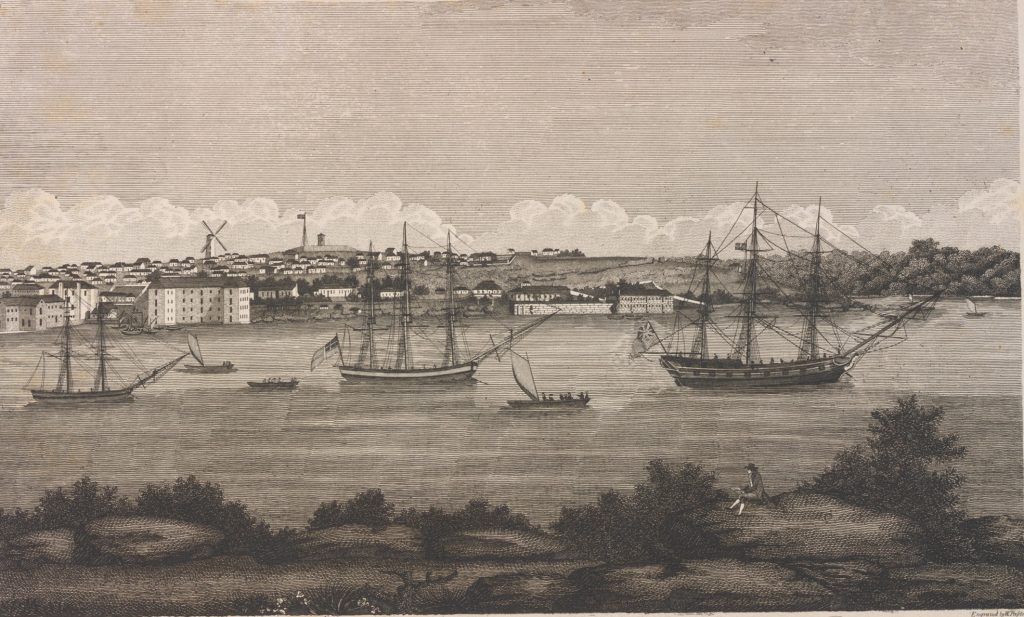
This view of Sydney shows a well-established township at the time the ill-fated convict ships Surry, General Hewitt and Three Bees arrived in 1814. State Library of New South Wales.
It is significant to note that upon receiving the report, the Commissioners of the Transport Board in London, immediately adopted the major part of Redfern’s advice. The transportation system was reformed and the outcome of future convict voyages was vastly improved. The recommendations were so successful that passenger ships in the 19th century also followed the procedures outlined in the report.
Outcomes
Unfortunately for Redfern, he suffered from Commissioner Bigge’s presence in the colony and the British authorities concern about former convicts holding important positions. Despite Redfern’s experience and abilities, he was disregarded for the post of principal surgeon due to his convict background and he resigned from the Colonial Medical Service in 1819. He remained in the colony as a well-loved, friendly and trustworthy physician until his retirement in 1826. A Sydney suburb is named in his honour, on the land which he once owned, however, his contribution to improving the convict experience is largely unknown. As medical historian Edward Ford wrote, “ Redfern’s report on the convict ships is one of the major Australian contributions to Public Health”5.
Detractors of Governor Macquarie criticised the improvements to the transport service claiming that it removed the element of terror associated with the voyage. They argued that by removing this dread, transportation would cease to be viewed as a deterrent and crime would escalate. Regardless of Redfern’s significant contribution to the welfare of convicts and the early colony, it seems the predominant impression of transportation has remained one of ghastliness. By considering the overall context of living conditions for the majority of common people at the time, a different picture of convict life emerges. Although convicts undoubtedly suffered as they underwent transportation, there are glimpses of music and dancing on the decks of convict ships.
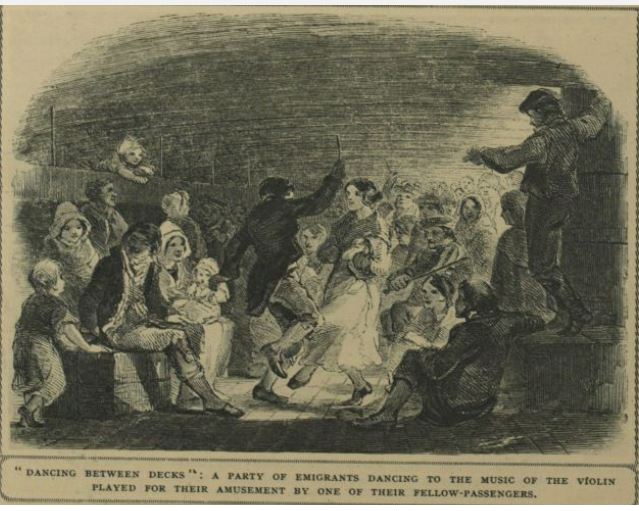
THE ILLUSTRATED LONDON NEWS. ( July 6, 1850.)
Redfern’s report on convict transports lead to improvements on emigrant ships, making government supervised voyages to Australia safer than a voyage to America. “Dancing to music played by emigrants … was recommended as an excellent exercise for alleviating ennui, reviving the spirits and promoting appetite and good health”6.
The theatre
In the 1830s, The Mutiny at Nore; or, British Soldiers 1797 was transformed into a nautical drama in three parts in the Theatres Royal, London. A copy including “remarks, biographical and critical; to which are added, a description of the costume, cast of the characters, entrances and exits, relative positions of the performers on the stage, and the whole of the stage business” is held in the State Library of Victoria.
The play premiered in Sydney on 8 October 1833, and remained a popular production throughout Australia for many years, with performances in Adelaide, Ballarat, Bendigo, Brisbane, Geelong, Hobart, Launceston, Melbourne, and Rockhampton The last performance of this “celebrated” and “magnificent” nautical drama appears to have been in Wallsend, Newcastle in 1907.
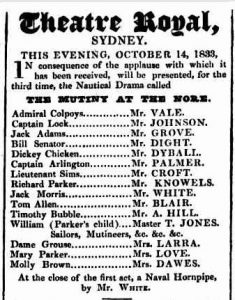
This performance of The Mutiny at the Nore featured a Naval Hornpipe by Mr Frederick White, a dancing master who had arrived in the colony as a convict.
References
1 Ford, Edward (1967). Redfern, William (1774 – 1833), Australian Dictionary of Biography, Volume 2, Melbourne University Press, pp 368-371. http://www.adb.online.anu.edu.au/biogs/A020324b.htm
2 Redfern, W., & Edited by Watson, F. (1814). Report on Convict Ships. La Trobe University Library: Historical records of Australia. Series I Retrieved from http://hdl.handle.net/1959.9/519540.
3 Ibid., page 285
4 Ibid., page 293
5Ford, E. (1953). The life and work of William Redfern: Australasian Medical Publishing Company Sydney.
6 Haines, Robin (2003). Life and death in the age of sail : the passage to Australia. University of New South Wales Press, Sydney, N.S.W
Dunlop, Norman J. (1928). William Redfern, the first Australian medical graduate and his times. http://nla.gov.au/nla.obj-371374713
____________________________________________________________
The information on this website www.historicaldance.au may be copied for personal use only, and must be acknowledged as from this website. It may not be reproduced for publication without prior permission from Dr Heather Blasdale-Clarke.



2 Responses to Dr William Redfern